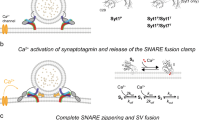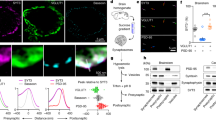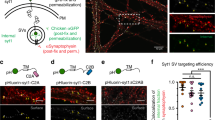Abstract
Ca2+-triggered synchronous neurotransmitter release is well described, but asynchronous release—in fact, its very existence—remains enigmatic. Here we report a quantitative description of asynchronous neurotransmitter release in calyx-of-Held synapses. We show that deletion of synaptotagmin 2 (Syt2) in mice selectively abolishes synchronous release, allowing us to study pure asynchronous release in isolation. Using photolysis experiments of caged Ca2+, we demonstrate that asynchronous release displays a Ca2+ cooperativity of ∼2 with a Ca2+ affinity of ∼44 μM, in contrast to synchronous release, which exhibits a Ca2+ cooperativity of ∼5 with a Ca2+ affinity of ∼38 μM. Our results reveal that release triggered in wild-type synapses at low Ca2+ concentrations is physiologically asynchronous, and that asynchronous release completely empties the readily releasable pool of vesicles during sustained elevations of Ca2+. We propose a dual-Ca2+-sensor model of release that quantitatively describes the contributions of synchronous and asynchronous release under conditions of different presynaptic Ca2+ dynamics.
This is a preview of subscription content, access via your institution
Access options
Subscribe to this journal
Receive 51 print issues and online access
$199.00 per year
only $3.90 per issue
Buy this article
- Purchase on Springer Link
- Instant access to full article PDF
Prices may be subject to local taxes which are calculated during checkout





Similar content being viewed by others
References
Meinrenken, C. J., Borst, J. G. & Sakmann, B. Local routes revisited: the space and time dependence of the Ca2+ signal for phasic transmitter release at the rat calyx of Held. J. Physiol. (Lond.) 547, 665–689 (2003)
Schneggenburger, R. & Neher, E. Presynaptic calcium and control of vesicle fusion. Curr. Opin. Neurobiol. 15, 266–274 (2005)
Atluri, P. P. & Regehr, W. G. Delayed release of neurotransmitter from cerebellar granule cells. J. Neurosci. 18, 8214–8227 (1998)
Lu, T. & Trussell, L. O. Inhibitory transmission mediated by asynchronous transmitter release. Neuron 26, 683–694 (2000)
Hagler, D. J. & Goda, Y. Properties of synchronous and asynchronous release during pulse train depression in cultured hippocampal neurons. J. Neurophysiol. 85, 2324–2334 (2001)
Otsu, Y. et al. Competition between phasic and asynchronous release for recovered synaptic vesicles at developing hippocampal autaptic synapses. J. Neurosci. 24, 420–433 (2004)
Hefft, S. & Jonas, P. Asynchronous GABA release generates long-lasting inhibition at a hippocampal interneuron–principal neuron synapse. Nature Neurosci. 8, 1319–1328 (2005)
Forsythe, I. D. Direct patch recording from identified presynaptic terminals mediating glutamatergic EPSCs in the rat CNS, in vitro . J. Physiol. (Lond.) 479, 381–387 (1994)
Borst, J. G. & Sakmann, B. Calcium influx and transmitter release in a fast CNS synapse. Nature 383, 431–434 (1996)
Sun, J. Y. & Wu, L. G. Fast kinetics of exocytosis revealed by simultaneous measurements of presynaptic capacitance and postsynaptic currents at a central synapse. Neuron 30, 171–182 (2001)
Schneggenburger, R. & Neher, E. Intracellular calcium dependence of transmitter release rates at a fast central synapse. Nature 406, 889–893 (2000)
Bollmann, J. H., Sakmann, B. & Borst, J. G. Calcium sensitivity of glutamate release in a calyx-type terminal. Science 289, 953–957 (2000)
Geppert, M. et al. Synaptotagmin I: a major Ca2+ sensor for transmitter release at a central synapse. Cell 79, 717–727 (1994)
Fernandez-Chacon, R. et al. Synaptotagmin I functions as a Ca2+-regulator of release probability. Nature 410, 41–49 (2001)
Stevens, C. F. & Sullivan, J. M. The synaptotagmin C2A domain is part of the calcium sensor controlling fast synaptic transmission. Neuron 39, 299–308 (2003)
Nagy, G. et al. Different effects on fast exocytosis induced by synaptotagmin 1 and 2 isoforms and abundance, but not by phosphorylation. J. Neurosci. 26, 632–643 (2006)
Pang, Z. P. et al. Synaptotagmin-2 is essential for survival and contributes to Ca2+ triggering of neurotransmitter release in central and neuromuscular synapses. J. Neurosci. 26, 13493–13504 (2006)
Xu, J., Mashimo, T. & Südhof, T. C. Synaptotagmin-1, -2, and -9: Ca2+-sensors for fast release that specify distinct presynaptic properties in subsets of neurons. Neuron 54, 801–812 (2007)
Pang, Z. P., Sun, J., Rizo, J., Maximov, A. & Südhof, T. C. Genetic analysis of Syt2 in spontaneous and Ca2+-triggered neurotransmitter release. EMBO J. 25, 2039–2050 (2006)
Goda, Y. & Stevens, C. F. Two components of transmitter release at a central synapse. Proc. Natl Acad. Sci. USA 91, 12942–12946 (1994)
Ravin, R., Spira, M. E., Parnas, H. & Parnas, I. Simultaneous measurement of intracellular Ca2+ and asynchronous transmitter release from the same crayfish bouton. J. Physiol. (Lond.) 501, 251–262 (1997)
Maximov, A. & Südhof, T. C. Autonomous function of synaptotagmin 1 in triggering asynchronous release independent of asynchronous release. Neuron 48, 547–554 (2005)
Chuhma, N. & Ohmori, H. Role of Ca2+ in the synchronization of transmitter release at calyceal synapses in the auditory system of rat. J. Neurophysiol. 87, 222–228 (2002)
Schneggenburger, R. & Forsythe, I. D. The calyx of Held. Cell Tissue Res. 326, 311–337 (2006)
Lou, X., Scheuss, V. & Schneggenburger, R. Allosteric modulation of the presynaptic Ca2+ sensor for vesicle fusion. Nature 435, 497–501 (2005)
Iwasaki, S. & Takahashi, T. Developmental changes in calcium channel types mediating synaptic transmission in rat auditory brainstem. J. Physiol. (Lond.) 509, 419–423 (1998)
Wu, L. G., Westenbroek, R. E., Borst, J. G., Catterall, W. A. & Sakmann, B. Calcium channel types with distinct presynaptic localization couple differentially to transmitter release in single calyx-type synapses. J. Neurosci. 19, 726–736 (1999)
Leveque, C. et al. Purification of the N-type calcium channel associated with syntaxin and synaptotagmin. A complex implicated in synaptic vesicle exocytosis. J. Biol. Chem. 269, 6306–6312 (1994)
Charvin, N. et al. Direct interaction of the calcium sensor protein synaptotagmin I with a cytoplasmic domain of the α1A subunit of the P/Q-type calcium channel. EMBO J. 16, 4591–4596 (1997)
Zhong, H., Yokoyama, C. T., Scheuer, T. & Catterall, W. A. Reciprocal regulation of P/Q-type Ca2+ channels by SNAP-25, syntaxin and synaptotagmin. Nature Neurosci. 2, 939–941 (1999)
Sakaba, T. & Neher, E. Quantitative relationship between transmitter release and calcium current at the calyx of Held synapse. J. Neurosci. 21, 462–476 (2001)
Stevens, C. F. & Wesseling, J. F. Activity-dependent modulation of the rate at which synaptic vesicles become available to undergo exocytosis. Neuron 21, 415–424 (1998)
Mulkey, R. M. & Zucker, R. S. Action potentials must admit calcium to evoke transmitter release. Nature 350, 153–155 (1991)
Heidelberger, R., Heinemann, C., Neher, E. & Matthews, G. Calcium dependence of the rate of exocytosis in a synaptic terminal. Nature 371, 513–515 (1994)
Awatramani, G. B., Price, G. D. & Trussell, L. O. Modulation of transmitter release by presynaptic resting potential and background calcium levels. Neuron 48, 109–121 (2005)
Taschenberger, H., Scheuss, V. & Neher, E. Release kinetics, quantal parameters and their modulation during short-term depression at a developing synapse in the rat CNS. J. Physiol. (Lond.) 568, 513–537 (2005)
Wadel, K., Neher, E. & Sakaba, T. The coupling between synaptic vesicles and Ca2+ channels determines fast neurontransmitter release. Neuron 53, 563–575 (2007)
Wölfel, M., Lou, X. & Schneggenburger, R. A mechanism intrinsic to the vesicle fusion machinery determines fast and slow transmitter release at a large CAN synapse. J. Neurosci. 27, 3198–3210 (2007)
Trommershauser, J., Schneggenburger, R., Zippelius, A. & Neher, E. Heterogeneous presynaptic release probabilities: functional relevance for short-term plasticity. Biophys. J. 84, 1563–1579 (2003)
Kushmerick, C., Renden, R. & von Gersdorff, H. Physiological temperatures reduce the rate of vesicle pool depletion and short-term depression via an acceleration of vesicle recruitment. J. Neurosci. 26, 1366–1377 (2006)
Bollmann, J. H. & Sakmann, B. Control of synaptic strength and timing by the release-site Ca2+ signal. Nature Neurosci. 8, 426–434 (2005)
Sun, J., Bronk, P., Liu, X., Han, W. & Südhof, T. C. Synapsins regulate use-dependent synaptic plasticity in the calyx of Held by a Ca2+/calmodulin-dependent pathway. Proc. Natl Acad. Sci. USA 103, 2880–2885 (2006)
Grynkiewicz, G., Poenie, M. & Tsien, R. Y. A new generation of Ca2+ indicators with greatly improved fluorescence properties. J. Biol. Chem. 260, 3440–3450 (1985)
Acknowledgements
We thank I. Kornblum, A. Roth, L. Fan and J. Mitchell for excellent technical assistance, and J. Bollmann, X. Lou and R. Schneggenburger for advice. This study was supported by a grant from NARSAD (to J.S.) and by The University of Texas M. D. Anderson Cancer Center Physician Scientist Program (R.A.).
Author Contributions J.S. performed the electrophysiology and photolysis experiments and modelling. Z.P.P. carried out the biochemical, immunohistochemical, and mouse genetics experiments; D.Q. participated in the electrophysiology and photolysis experiments; A.T. F. and R.A. generated the Syt2 knockout mice, and T.C.S. and J.S. designed the experiments and wrote the manuscript.
Author information
Authors and Affiliations
Corresponding authors
Supplementary information
Supplementary Information
The file contains Supplementary Methods with additional references, Supplementary Tables 1-2 and Supplementary Figures 1-14 with Legends. (PDF 1893 kb)
Rights and permissions
About this article
Cite this article
Sun, J., Pang, Z., Qin, D. et al. A dual-Ca2+-sensor model for neurotransmitter release in a central synapse. Nature 450, 676–682 (2007). https://doi.org/10.1038/nature06308
Received:
Accepted:
Published:
Issue Date:
DOI: https://doi.org/10.1038/nature06308
This article is cited by
-
Rasal1 regulates calcium dependent neuronal maturation by modifying microtubule dynamics
Cell & Bioscience (2024)
-
Integrated analysis of mRNAs and lncRNAs reveals candidate marker genes and potential hub lncRNAs associated with growth regulation of the Pacific Oyster, Crassostrea gigas
BMC Genomics (2023)
-
The release of inhibition model reproduces kinetics and plasticity of neurotransmitter release in central synapses
Communications Biology (2023)
-
Electrostatic regulation of the cis- and trans-membrane interactions of synaptotagmin-1
Scientific Reports (2022)
-
Expression and Neurotransmitter Association of the Synaptic Calcium Sensor Synaptotagmin in the Avian Auditory Brain Stem
Journal of the Association for Research in Otolaryngology (2022)
Comments
By submitting a comment you agree to abide by our Terms and Community Guidelines. If you find something abusive or that does not comply with our terms or guidelines please flag it as inappropriate.



